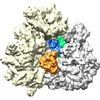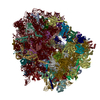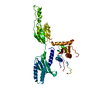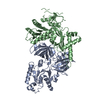+ Open data
Open data
- Basic information
Basic information
| Entry | Database: EMDB / ID: EMD-2597 | |||||||||
|---|---|---|---|---|---|---|---|---|---|---|
| Title | Cryo-EM of a pretermination complex with eRF1 and eRF3 | |||||||||
 Map data Map data | Complex locked with nonhydrolyzable GTP analog GDPNP | |||||||||
 Sample Sample |
| |||||||||
 Keywords Keywords | translation / termination / cryo-EM | |||||||||
| Function / homology |  Function and homology information Function and homology informationsno(s)RNA transcription / Eukaryotic Translation Termination / translation release factor complex / cytoplasmic translational termination / translation release factor activity, codon specific / translation release factor activity / sequence-specific mRNA binding / peptidyl-tRNA hydrolase activity / nuclear-transcribed mRNA catabolic process, deadenylation-dependent decay / Nonsense Mediated Decay (NMD) independent of the Exon Junction Complex (EJC) ...sno(s)RNA transcription / Eukaryotic Translation Termination / translation release factor complex / cytoplasmic translational termination / translation release factor activity, codon specific / translation release factor activity / sequence-specific mRNA binding / peptidyl-tRNA hydrolase activity / nuclear-transcribed mRNA catabolic process, deadenylation-dependent decay / Nonsense Mediated Decay (NMD) independent of the Exon Junction Complex (EJC) / Nonsense Mediated Decay (NMD) enhanced by the Exon Junction Complex (EJC) / translational termination / DNA-templated transcription termination / cytoplasmic stress granule / regulation of translation / ribosome binding / Hydrolases; Acting on acid anhydrides; Acting on GTP to facilitate cellular and subcellular movement / translation / GTPase activity / mRNA binding / GTP binding / identical protein binding / cytosol / cytoplasm Similarity search - Function | |||||||||
| Biological species |   | |||||||||
| Method | single particle reconstruction / cryo EM / negative staining / Resolution: 9.15 Å | |||||||||
 Authors Authors | Preis A / Heuer A / Barrio-Garcia C / Hauser A / Eyler D / Berninghausen O / Green R / Becker T / Beckmann R | |||||||||
 Citation Citation |  Journal: Cell Rep / Year: 2014 Journal: Cell Rep / Year: 2014Title: Cryoelectron microscopic structures of eukaryotic translation termination complexes containing eRF1-eRF3 or eRF1-ABCE1. Authors: Anne Preis / Andre Heuer / Clara Barrio-Garcia / Andreas Hauser / Daniel E Eyler / Otto Berninghausen / Rachel Green / Thomas Becker / Roland Beckmann /   Abstract: Termination and ribosome recycling are essential processes in translation. In eukaryotes, a stop codon in the ribosomal A site is decoded by a ternary complex consisting of release factors eRF1 and ...Termination and ribosome recycling are essential processes in translation. In eukaryotes, a stop codon in the ribosomal A site is decoded by a ternary complex consisting of release factors eRF1 and guanosine triphosphate (GTP)-bound eRF3. After GTP hydrolysis, eRF3 dissociates, and ABCE1 can bind to eRF1-loaded ribosomes to stimulate peptide release and ribosomal subunit dissociation. Here, we present cryoelectron microscopic (cryo-EM) structures of a pretermination complex containing eRF1-eRF3 and a termination/prerecycling complex containing eRF1-ABCE1. eRF1 undergoes drastic conformational changes: its central domain harboring the catalytically important GGQ loop is either packed against eRF3 or swung toward the peptidyl transferase center when bound to ABCE1. Additionally, in complex with eRF3, the N-terminal domain of eRF1 positions the conserved NIKS motif proximal to the stop codon, supporting its suggested role in decoding, yet it appears to be delocalized in the presence of ABCE1. These results suggest that stop codon decoding and peptide release can be uncoupled during termination. | |||||||||
| History |
|
- Structure visualization
Structure visualization
| Movie |
 Movie viewer Movie viewer |
|---|---|
| Structure viewer | EM map:  SurfView SurfView Molmil Molmil Jmol/JSmol Jmol/JSmol |
| Supplemental images |
- Downloads & links
Downloads & links
-EMDB archive
| Map data |  emd_2597.map.gz emd_2597.map.gz | 20.5 MB |  EMDB map data format EMDB map data format | |
|---|---|---|---|---|
| Header (meta data) |  emd-2597-v30.xml emd-2597-v30.xml emd-2597.xml emd-2597.xml | 12.2 KB 12.2 KB | Display Display |  EMDB header EMDB header |
| Images |  EMD-2597-eRF3_overview_side.png EMD-2597-eRF3_overview_side.png | 238.9 KB | ||
| Archive directory |  http://ftp.pdbj.org/pub/emdb/structures/EMD-2597 http://ftp.pdbj.org/pub/emdb/structures/EMD-2597 ftp://ftp.pdbj.org/pub/emdb/structures/EMD-2597 ftp://ftp.pdbj.org/pub/emdb/structures/EMD-2597 | HTTPS FTP |
-Validation report
| Summary document |  emd_2597_validation.pdf.gz emd_2597_validation.pdf.gz | 268.1 KB | Display |  EMDB validaton report EMDB validaton report |
|---|---|---|---|---|
| Full document |  emd_2597_full_validation.pdf.gz emd_2597_full_validation.pdf.gz | 267.2 KB | Display | |
| Data in XML |  emd_2597_validation.xml.gz emd_2597_validation.xml.gz | 7 KB | Display | |
| Arichive directory |  https://ftp.pdbj.org/pub/emdb/validation_reports/EMD-2597 https://ftp.pdbj.org/pub/emdb/validation_reports/EMD-2597 ftp://ftp.pdbj.org/pub/emdb/validation_reports/EMD-2597 ftp://ftp.pdbj.org/pub/emdb/validation_reports/EMD-2597 | HTTPS FTP |
-Related structure data
| Related structure data |  4crnMC  2598C  4crmC M: atomic model generated by this map C: citing same article ( |
|---|---|
| Similar structure data |
- Links
Links
| EMDB pages |  EMDB (EBI/PDBe) / EMDB (EBI/PDBe) /  EMDataResource EMDataResource |
|---|---|
| Related items in Molecule of the Month |
- Map
Map
| File |  Download / File: emd_2597.map.gz / Format: CCP4 / Size: 185.7 MB / Type: IMAGE STORED AS FLOATING POINT NUMBER (4 BYTES) Download / File: emd_2597.map.gz / Format: CCP4 / Size: 185.7 MB / Type: IMAGE STORED AS FLOATING POINT NUMBER (4 BYTES) | ||||||||||||||||||||||||||||||||||||||||||||||||||||||||||||||||||||
|---|---|---|---|---|---|---|---|---|---|---|---|---|---|---|---|---|---|---|---|---|---|---|---|---|---|---|---|---|---|---|---|---|---|---|---|---|---|---|---|---|---|---|---|---|---|---|---|---|---|---|---|---|---|---|---|---|---|---|---|---|---|---|---|---|---|---|---|---|---|
| Annotation | Complex locked with nonhydrolyzable GTP analog GDPNP | ||||||||||||||||||||||||||||||||||||||||||||||||||||||||||||||||||||
| Projections & slices | Image control
Images are generated by Spider. | ||||||||||||||||||||||||||||||||||||||||||||||||||||||||||||||||||||
| Voxel size | X=Y=Z: 1.2375 Å | ||||||||||||||||||||||||||||||||||||||||||||||||||||||||||||||||||||
| Density |
| ||||||||||||||||||||||||||||||||||||||||||||||||||||||||||||||||||||
| Symmetry | Space group: 1 | ||||||||||||||||||||||||||||||||||||||||||||||||||||||||||||||||||||
| Details | EMDB XML:
CCP4 map header:
| ||||||||||||||||||||||||||||||||||||||||||||||||||||||||||||||||||||
-Supplemental data
- Sample components
Sample components
-Entire : "CMV"-stalled wheat germ 80S-RNC bound to eRF1 and eRF3-GDPNP
| Entire | Name: "CMV"-stalled wheat germ 80S-RNC bound to eRF1 and eRF3-GDPNP |
|---|---|
| Components |
|
-Supramolecule #1000: "CMV"-stalled wheat germ 80S-RNC bound to eRF1 and eRF3-GDPNP
| Supramolecule | Name: "CMV"-stalled wheat germ 80S-RNC bound to eRF1 and eRF3-GDPNP type: sample / ID: 1000 Oligomeric state: One ribosome binds to one eRF1 and one eRF3 Number unique components: 3 |
|---|
-Supramolecule #1: 80S ribosome
| Supramolecule | Name: 80S ribosome / type: complex / ID: 1 / Recombinant expression: No / Ribosome-details: ribosome-eukaryote: ALL |
|---|---|
| Source (natural) | Organism:  |
-Macromolecule #1: Sup45
| Macromolecule | Name: Sup45 / type: protein_or_peptide / ID: 1 / Name.synonym: eRF1 / Number of copies: 1 / Oligomeric state: 1 / Recombinant expression: Yes |
|---|---|
| Source (natural) | Organism:  |
| Molecular weight | Theoretical: 49 KDa |
| Recombinant expression | Organism:  |
-Macromolecule #2: Sup35
| Macromolecule | Name: Sup35 / type: protein_or_peptide / ID: 2 / Name.synonym: eRF3 Details: Sup35 was N-terminally deleted for the first 97 amino acids Number of copies: 1 / Oligomeric state: 1 / Recombinant expression: Yes |
|---|---|
| Source (natural) | Organism:  |
| Molecular weight | Theoretical: 76 KDa |
| Recombinant expression | Organism:  |
-Experimental details
-Structure determination
| Method | negative staining, cryo EM |
|---|---|
 Processing Processing | single particle reconstruction |
| Aggregation state | particle |
- Sample preparation
Sample preparation
| Buffer | pH: 7.5 Details: 20 mM HEPES pH 7.5, 200 mM KCl, 1.5 MgCl2, 2 mM DTT, 0.01 mg/ml cycloheximide, 0.05 % Nikkol, 0.03 % DBC, 0.5 mM GDPNP). |
|---|---|
| Staining | Type: NEGATIVE / Details: Cryo-EM |
| Grid | Details: Sec61 was added at a five-fold molar excess to saturate the hydrophobic signal-anchor sequence and avoid orientational bias on the cryo-grids |
| Vitrification | Cryogen name: ETHANE / Chamber humidity: 100 % / Instrument: FEI VITROBOT MARK IV / Method: Blot for 3 seconds before plunging |
- Electron microscopy
Electron microscopy
| Microscope | FEI TITAN KRIOS |
|---|---|
| Date | Feb 20, 2013 |
| Image recording | Category: CCD / Film or detector model: TVIPS TEMCAM-F416 (4k x 4k) / Digitization - Sampling interval: 15.6 µm / Average electron dose: 20 e/Å2 / Bits/pixel: 16 |
| Electron beam | Acceleration voltage: 200 kV / Electron source:  FIELD EMISSION GUN FIELD EMISSION GUN |
| Electron optics | Calibrated magnification: 147136 / Illumination mode: FLOOD BEAM / Imaging mode: BRIGHT FIELD / Cs: 2.7 mm |
| Sample stage | Specimen holder model: FEI TITAN KRIOS AUTOGRID HOLDER |
| Experimental equipment |  Model: Titan Krios / Image courtesy: FEI Company |
- Image processing
Image processing
| Details | The particles were picked with starfish_boxing version 0.2.0, which is part of the new StarFish single particle analysis program suite. |
|---|---|
| CTF correction | Details: on volumes (SPIDER) |
| Final reconstruction | Applied symmetry - Point group: C1 (asymmetric) / Algorithm: OTHER / Resolution.type: BY AUTHOR / Resolution: 9.15 Å / Resolution method: OTHER / Software - Name: Star, Fish, SPIDER / Details: Data-subset resulted from computational sorting / Number images used: 39309 |
-Atomic model buiding 1
| Initial model | PDB ID: |
|---|---|
| Software | Name: Chimera, Coot |
| Details | A homology model for eRF1 was built using HHPred; The domains were separately fitted by manual docking using programs Coot and Chimera |
| Refinement | Space: REAL / Protocol: RIGID BODY FIT |
| Output model |  PDB-4crn: |
-Atomic model buiding 2
| Initial model | PDB ID: |
|---|---|
| Software | Name: Chimera, Coot |
| Details | A homology model for eRF3 was built using HHPred; The domains were separately fitted by manual docking using programs Coot and Chimera |
| Refinement | Space: REAL / Protocol: RIGID BODY FIT |
| Output model |  PDB-4crn: |
 Movie
Movie Controller
Controller





















 Z (Sec.)
Z (Sec.) X (Row.)
X (Row.) Y (Col.)
Y (Col.)























